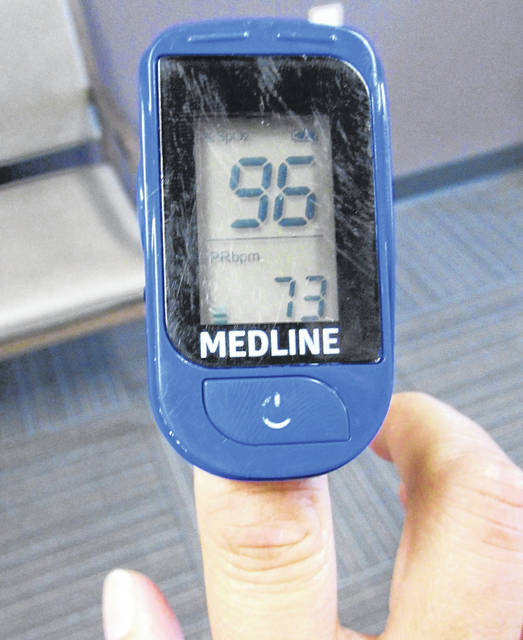
Congressional representative Brad Wenstrup (R-Ohio) thinks there is more that can be done to treat coronavirus patients before the illness progresses into dangerous territory.
Wenstrup, who is also a physician, told The Times-Gazette that a device that is commonly used in hospitals, doctors offices and in many private homes could prove to be a safe and effective way to detect the early signs of compromised lung function.
It’s called a pulse oximeter, commonly referred to in medical circles as a “pulse ox,” and it measures a person’s heart rate and their “02 sats,” or blood oxygen saturation levels, which for a healthy person are usually in the mid to upper 90s.
Physicians and hospitals routinely use the device, and local durable medical equipment companies such as Genesis and Littleton’s use it to help qualify patients for home oxygen therapy.
Research into the disease has shown that COVID-19 can begin to erode lung capacity before the patient realizes it, and Wenstrup feels that early detection of lung issues caused by the virus would help save lives.
“Some colleagues of mine and I were looking at this maybe four or five months ago when we were trying to develop tests,” he said. “We knew that knowing someone’s oxygen level was going to be important, and now it’s one of the criteria before you admit somebody to the hospital.”
He said as a physician, the sooner he could treat someone with the virus, the greater chance they would have of making a complete recovery, and he noted that even when they got better, some patients still had to cope with reduced lung function due to the damage COVID-19 inflicts.
Wenstrup recently met with the Food & Drug Administration in an effort to promote the use of the pulse oximeter to proactively monitor those who have tested positive and are self-isolating in quarantine.
“Using a pulse oximeter is so easy,” he said. “You put it on your finger and it gives you your level — I just ordered one on Amazon and it was like $25, and you can use it every hour if you like.”
For a person who tested positive for COVID-19, he said it wouldn’t be a bad idea to do a pulse ox reading at the time of testing as a baseline.
“If you do a test and don’t have the results back yet, and at the same time they’re not feeling bad, but they’re down to 90 or below, it’s a good guess they’ve got it,” he said.
He said that a patient who was self-quarantining and using a pulse ox would be able to tell if they were getting progressively worse even before they felt it.
There are several different opinions regarding the accuracy of the pulse oximeter, such as what finger will give the most accurate measurement and whether nail polish will affect a correct reading for women.
Shana Sarbach is a respiratory therapist for Genesis Oxygen & Home Medical Equipment in Hillsboro. She said that even though it is typically placed on the index finger, any finger will provide a pulse ox with a true measurement.
According to the National Library of Medicine, studies did show that some, but not all nail polishes, absorbed light at the wavelengths used by the pulse oximeter, so they recommended that all nail polish be removed before using the device for monitoring.
Wenstrup said early indications of an oxygen level drop would give physicians like himself a better chance of preventing COVID-19 patients from escalating health issues that could land them in an intensive care unit.
He said he is hoping the Trump administration’s COVID-19 task force would do more to promote the use of pulse oximeters, and to encourage Medicare and Medicaid to start paying for the device for patients when it’s needed.
Reach Tim Colliver at 937-402-2571.


